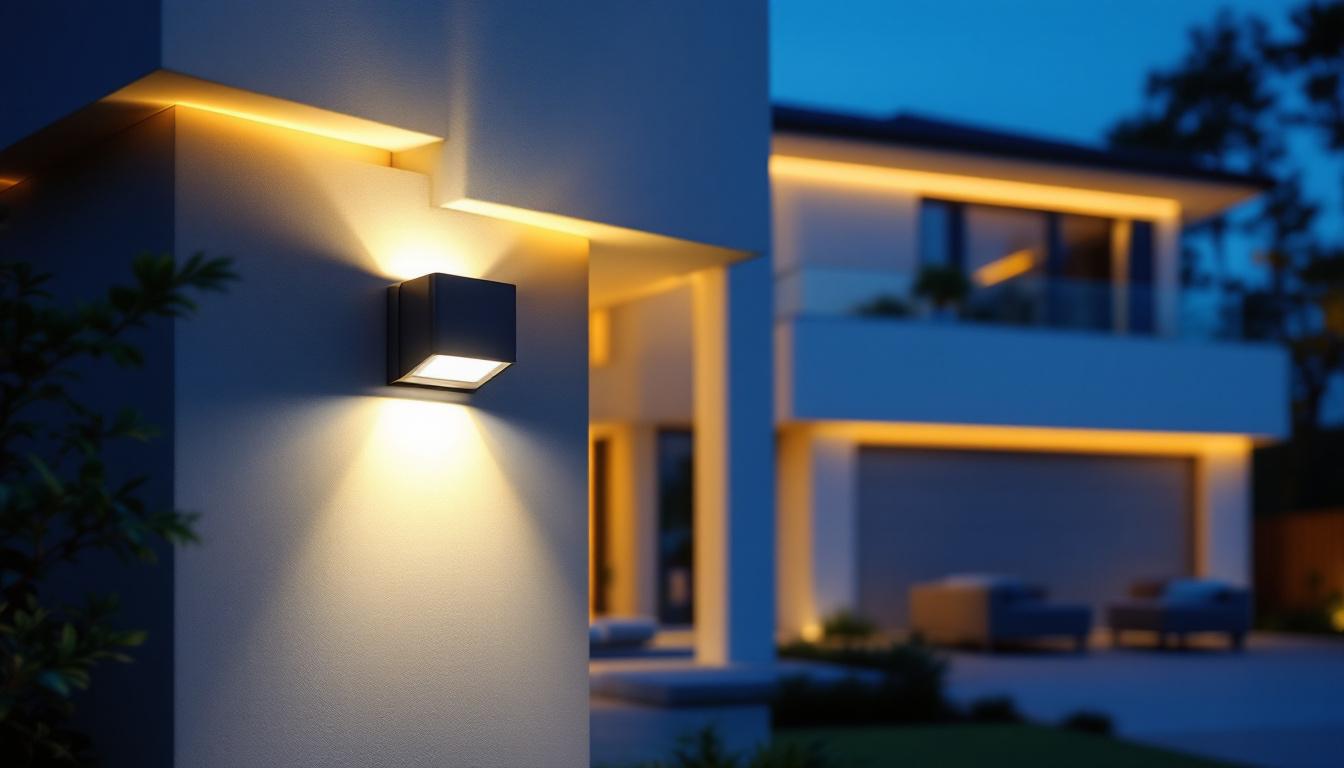
Motion lights have revolutionized the way residential properties are illuminated, offering both functionality and security. As technology continues to advance, homeowners are increasingly turning to motion-activated lighting solutions to enhance their living spaces. This shift not only improves energy efficiency but also elevates the overall aesthetic of a home. By utilizing sensors that detect movement, these lights can automatically turn on when someone approaches, providing convenience and peace of mind, especially during nighttime hours.
For lighting contractors, understanding the intricacies of motion lighting systems is essential. This article delves into the various aspects of motion lights, exploring their benefits, installation techniques, and future trends in lighting design. Additionally, the integration of smart technology has paved the way for more advanced motion lighting systems that can be controlled remotely via smartphones or smart home devices. This capability allows homeowners to customize their lighting preferences, set schedules, and even receive alerts when motion is detected, further enhancing the security of their property.
Moreover, the versatility of motion lights extends beyond mere security; they can also be used to create ambiance in outdoor living spaces. For instance, strategically placed motion lights along pathways or in gardens can highlight landscaping features while providing safe navigation after dark. With various styles and finishes available, homeowners can choose fixtures that complement their exterior decor, making motion lighting not just a practical choice but also a stylish one. As energy-efficient LED technology becomes more prevalent, these lights are also becoming more affordable to run, making them an attractive option for eco-conscious consumers.
One of the primary advantages of motion lights is their ability to enhance security. By illuminating areas only when movement is detected, these lights deter potential intruders and provide homeowners with peace of mind. Strategically placing motion sensors around entry points, driveways, and dark corners can significantly reduce the likelihood of break-ins.
Moreover, the sudden illumination can startle intruders, drawing attention to their presence. This proactive approach to security not only protects the home but also reassures residents and their families. In addition to deterring crime, motion lights can also help in monitoring wildlife activity around the property. Homeowners may find it fascinating to observe nocturnal animals, and the lights can provide a safe way to do so without disturbing the natural habitat.
Energy efficiency is a critical concern for many homeowners, and motion lights offer a practical solution. Traditional lighting systems often remain on for extended periods, wasting energy. In contrast, motion-activated lights only operate when necessary, reducing electricity consumption and lowering utility bills.
With the integration of LED technology, motion lights can provide bright illumination while consuming minimal power. This combination of motion sensors and energy-efficient bulbs makes them an attractive option for environmentally conscious homeowners. Furthermore, many motion lights come equipped with adjustable sensitivity settings and timers, allowing users to customize how long the lights remain on after activation. This feature not only enhances energy savings but also ensures that the lights are tailored to the specific needs of the household.
Motion lights also offer unparalleled convenience. Homeowners no longer need to fumble for switches in the dark; lights automatically turn on as they approach. This feature is particularly beneficial for outdoor spaces, such as pathways and patios, where visibility is crucial for safety.
Additionally, many modern motion lighting systems can be integrated with smart home technology, allowing homeowners to control their lighting remotely. This level of accessibility adds a layer of sophistication to residential lighting design. For instance, users can program their motion lights to work in tandem with other smart devices, such as security cameras or alarms, creating a comprehensive home security system. This interconnectedness not only enhances convenience but also provides a seamless user experience, making it easier than ever to manage home safety and ambiance from a single app or device.
Hardwired motion lights are a robust option for homeowners looking for permanent solutions. These systems are connected directly to the electrical wiring of the home, ensuring a reliable power source. Hardwired lights often provide more consistent performance compared to battery-operated alternatives.
Installation of hardwired systems typically requires professional assistance, making it an ideal project for lighting contractors. Proper placement and wiring can maximize the effectiveness of these lights, ensuring they cover the desired areas without gaps.
For those seeking flexibility, battery-operated motion lights present an excellent alternative. These lights can be installed in various locations without the need for electrical wiring, making them ideal for renters or temporary setups. They are particularly useful in outdoor spaces where access to power may be limited.
However, it is essential to consider the maintenance aspect of battery-operated systems. Regular battery replacement is necessary to ensure consistent performance, and contractors should inform clients about this requirement during installation.
Solar-powered motion lights are gaining popularity due to their eco-friendly nature. Utilizing solar panels to harness sunlight, these lights are an excellent option for outdoor areas where sunlight is abundant. They are easy to install and require minimal maintenance, making them a favorite among environmentally conscious homeowners.
While solar-powered lights can be less reliable in areas with limited sunlight, advancements in solar technology are continually improving their performance. Lighting contractors should stay informed about the latest developments in solar-powered motion lights to offer clients the best options available.
Proper placement of motion lights is crucial for maximizing their effectiveness. Lighting contractors should assess the property to identify high-traffic areas, entry points, and dark corners that require illumination. Ideally, motion sensors should be positioned at a height that allows them to detect movement effectively while minimizing false triggers from passing cars or animals.
For outdoor installations, it is essential to consider the angle and range of the motion sensor. Many modern systems offer adjustable sensitivity and range settings, allowing contractors to customize the performance based on the specific environment.
For hardwired systems, ensuring proper wiring and power supply is vital. Contractors should adhere to local electrical codes and regulations when installing motion lights. Additionally, it is advisable to use weatherproof fixtures and wiring for outdoor installations to withstand environmental elements.
Battery-operated and solar-powered systems require less technical expertise in wiring, but contractors should still provide guidance on optimal placement and maintenance to ensure longevity and performance.
As smart home technology continues to evolve, integrating motion lights with existing systems can enhance their functionality. Many homeowners are now looking for lighting solutions that can be controlled via smartphone apps or voice-activated devices. Contractors should familiarize themselves with various smart home platforms to provide clients with comprehensive solutions.
Integration not only allows for remote control but also enables homeowners to set schedules, adjust sensitivity levels, and receive notifications when motion is detected. This level of customization can significantly enhance the user experience and satisfaction.
The future of motion lighting is undoubtedly tied to advancements in sensor technology. Smart sensors equipped with artificial intelligence can learn patterns of movement, optimizing lighting based on user behavior. This automation can lead to even greater energy savings and convenience for homeowners.
As technology progresses, the integration of machine learning algorithms will allow motion lights to adapt to changing environments, providing tailored lighting solutions that meet the specific needs of each household.
As the demand for stylish home decor increases, manufacturers are focusing on the design aspects of motion lights. Sleek, modern designs that blend seamlessly with home architecture are becoming more prevalent. Lighting contractors should stay updated on the latest design trends to offer clients options that enhance their home’s aesthetic appeal.
From minimalist fixtures to decorative lanterns, the variety of styles available ensures that homeowners can find motion lighting solutions that complement their personal taste and enhance their living spaces.
With a growing emphasis on sustainability, the integration of motion lights with renewable energy sources is likely to become more mainstream. As solar technology advances, homeowners will increasingly seek options that reduce their carbon footprint while maintaining functionality.
Lighting contractors should be prepared to offer clients solutions that incorporate renewable energy, ensuring they remain competitive in a rapidly evolving market. This commitment to sustainability not only benefits the environment but also appeals to the eco-conscious consumer.
Motion lights represent the future of lighting design and installation, offering a perfect blend of security, energy efficiency, and convenience. For lighting contractors, staying informed about the latest trends, technologies, and installation techniques is essential to meet the evolving needs of homeowners.
As the market continues to grow, embracing motion lighting solutions will not only enhance residential properties but also position contractors as leaders in innovative lighting design. By understanding the benefits, types, and installation considerations of motion lights, contractors can provide valuable insights and services that cater to the demands of modern homeowners.
In a world where technology and design are increasingly intertwined, motion lights are poised to play a significant role in shaping the future of residential lighting. Embracing these advancements will ensure that lighting contractors remain at the forefront of the industry, ready to illuminate homes with style and efficiency.
Ready to lead the future of lighting design with innovative motion lights? At LumenWholesale, we provide lighting contractors with the highest quality, spec-grade lighting products at prices that can’t be beaten. Say goodbye to local distributor markups and hello to our premium selection that meets rigorous industry standards. Plus, with free shipping on bulk orders, you can stock up on the best lighting solutions without any hidden costs. Elevate your lighting projects with the perfect combination of quality, affordability, and convenience. Discover the value of wholesale lighting with LumenWholesale by visiting Wholesale Lighting at the Best Value today.

Discover the essential guide to light diffusers tailored for lighting contractors.

Discover the essential role of lamp post bases in enhancing energy efficiency and sustainability in urban lighting.

Explore the critical role of industrial dryer outlets in enhancing efficiency and safety for lighting contractors.

Discover how outdoor lights on houses have evolved into essential components of modern lighting solutions, enhancing aesthetics, security, and energy efficiency.